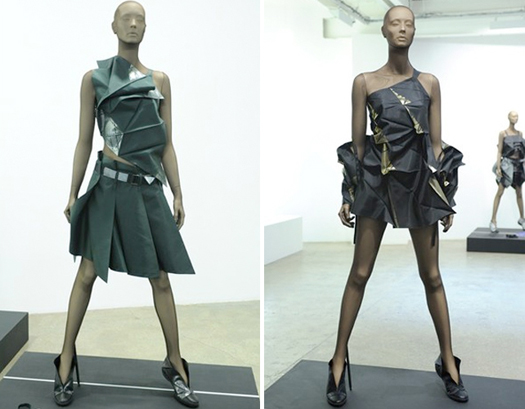
Dresses from Issey Miyake's 132 5 collection, on view in Paris. Photos from Women's Wear Daily.
Japanese designer Issey Miyake has long been a fashion innovator. Since handing over daily design duties at his Tokyo fashion house in 1997, Miyake has spent his time exploring new ways to make clothes more efficient, ecological and accessible while remaining stylish and modern. Today, he leads the Reality Lab, a consortium of young designers that, as he explains, “challenges, explores and celebrates the infinite possibilities of creativity.”
On September 7, Miyake unveiled the lab’s latest project — 132 5. ISSEY MIYAKE — at the Galerie Kreo on the Left Bank in Paris. The title explains the notion: one piece of fabric, a three-dimensional shape reduced to two, and the fifth dimension, which Miyake describes as the moment the garment is worn and comes to life “through the communication among people.” (In physics, the fifth dimension is a hypothetical extra dimension after the three spatial ones and the fourth, which is time. Some astrophysicists argue that the fifth dimension may be the universe that we live in.)
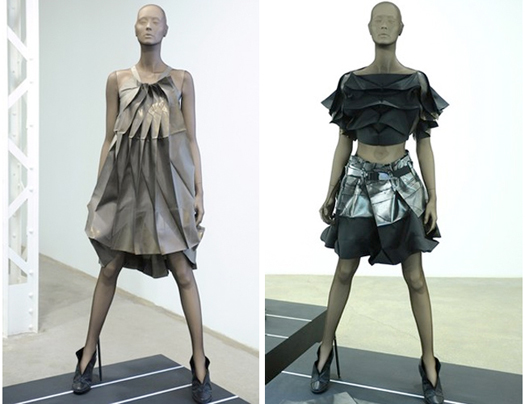
Dresses from Issey Miyake's 132 5 collection, on view in Paris. Photos from Women's Wear Daily.
The project began humbly enough: a member of Miyake’s lab was surfing the web two years ago and came across the work of Jun Mitani, a Japanese computer scientist who created a program to construct three-dimensional geometric forms from a simple piece of paper. Summoned to the Miyake Design Studio in Tokyo, Mitani was “dressed in a coat and tie and extremely nervous,” Miyake remembers. Miyake explained that he hoped to adapt Mitani’s concept for fashion. “Researchers are excellent at coming up with ideas, but they know nothing about merchandising,” Miyake says with a laugh.
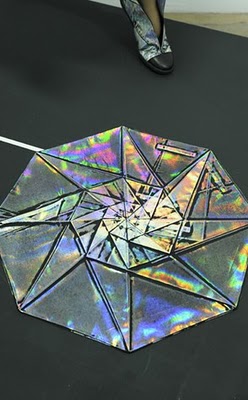
Folded fabric, ready to enter the third (and fifth) dimension. Photo from Women's Wear Daily.
First, the forms needed to be reconfigured from their cumbersome 3D volume to a more manageable two dimensional form — think of a flat paper Chinese lantern that, like an accordion, opens into a 3D globe. Because Miyake wanted the resulting garments as sustainable as possible, he worked with fabrics made of recycled plastic bottles — like Fleece, but much more refined. He chose a thin white textile that feels and looks like cotton poplin, and a shinier black fabric that resembles silk faille. The material is lightweight, stretches and breathes. For a more diverse palette, Miyake dyed the white poplin in two other colors — hunter green and bronze.
Instead of cutting and sewing, the fabric would be folded with sharp, precise, permanent creases — like those of origami — based on Mitani’s computer-generated formulas. When folded, the garments are pleasing flat round geometric shapes such as stars and swirls. When unfolded, they become multi-faceted angular tubes that can be worn as day dresses, cocktail dresses or a long skirt. To make the tubes more versatile, Miyake has placed invisible snaps at key points so they wearer can change the shape of the garment with temporary darts or attach a pair of tubes together to create pants or a jacket with sleeves. The silhouettes recall Miyake’s Parisian training in the early 1960s at Ecole de la Chambre Syndicale de la Haute Couture and as an assistant to legendary couturier Hubert de Givenchy, in particular the always-chic trapeze shape, the empire waist and the wide sculptural necklines of Givenchy’s mentor Cristobal Balenciaga. Yet the collection is also a natural extension of Miyake’s work in recent years, in particular PleatsPlease and A-POC, which is knitted tubular clothes made of a single piece of cloth.
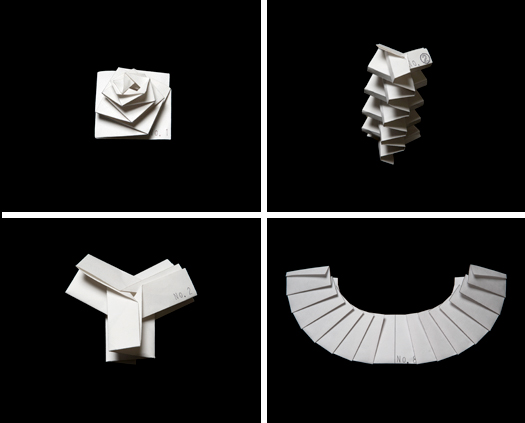
Follded fabric configurations. Images courtesy Issey Miyake.
In addition to the clothes, the line includes a selection of totes and handbags. It will be available in Miyake boutiques worldwide as well as a new 132 5. ISSEY MIYAKE store in Tokyo this autumn, and items will retail for less than $300. “These clothes are very light, like air, and are season-less,” Miyake says. “I hope people will keep them a long time, and not replace them every two months. That, for me, is the essence of sustainability.”
Instead of cutting and sewing, the fabric would be folded with sharp, precise, permanent creases — like those of origami — based on Mitani’s computer-generated formulas. When folded, the garments are pleasing flat round geometric shapes such as stars and swirls. When unfolded, they become multi-faceted angular tubes that can be worn as day dresses, cocktail dresses or a long skirt. To make the tubes more versatile, Miyake has placed invisible snaps at key points so they wearer can change the shape of the garment with temporary darts or attach a pair of tubes together to create pants or a jacket with sleeves. The silhouettes recall Miyake’s Parisian training in the early 1960s at Ecole de la Chambre Syndicale de la Haute Couture and as an assistant to legendary couturier Hubert de Givenchy, in particular the always-chic trapeze shape, the empire waist and the wide sculptural necklines of Givenchy’s mentor Cristobal Balenciaga. Yet the collection is also a natural extension of Miyake’s work in recent years, in particular PleatsPlease and A-POC, which is knitted tubular clothes made of a single piece of cloth.

Follded fabric configurations. Images courtesy Issey Miyake.
In addition to the clothes, the line includes a selection of totes and handbags. It will be available in Miyake boutiques worldwide as well as a new 132 5. ISSEY MIYAKE store in Tokyo this autumn, and items will retail for less than $300. “These clothes are very light, like air, and are season-less,” Miyake says. “I hope people will keep them a long time, and not replace them every two months. That, for me, is the essence of sustainability.”

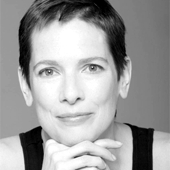
Comments [2]
09.20.10
12:40
I am a design student in Sri Lanka and going to do a project with origami techniqes and kindly request your coperation .
thanks
12.13.10
12:01